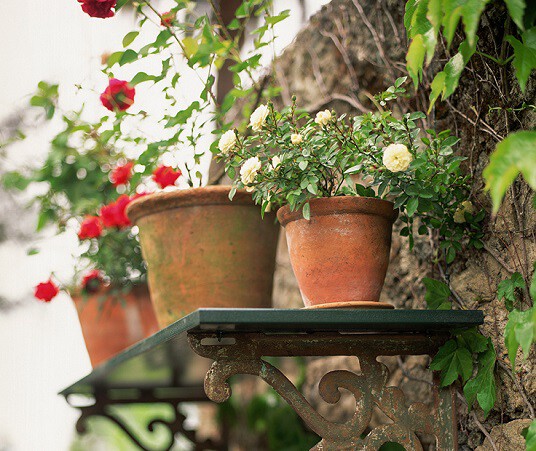Pots aren't one-plant-fits all—here's how to make sure you pick the right one.

Whether you're a seasoned gardener or a novice, you may be looking for a little more greenery in your life—especially now. We're in the thick of growing season, which means it's time to fill your planters with bright, beautiful flowers and lush greenery. But before you purchase a new-to-you variety and place it in one of the pots you have at home, take a beat: As it turns out, ensuring your potted plants will thrive—and look the way you want them to—begins with choosing the correct vessel. The most popular choices? Terra-cotta, ceramic, and concrete, says Adrienne Roethling, the director of curation and mission delivery at the Paul J. Ciener Botanical Garden. Ahead, the expert's best tips for choosing the right option for your own plants.
Terra-Cotta
This material is lighter physically and metaphorically: It's easier on your wallet and less cumbersome in your hands, but it can be more vulnerable to the elements. "This material allows water to move in the form of absorption or moisture loss, which can be a problem during severe cold," Roethling explains, adding that they are also more prone to breaking during a storm and should be moved somewhere safe when extreme weather or temperature drops are expected.
Ceramic
Ceramic pots, which often come glazed, are made from a heavier material and come in an array of shapes, colors, and sizes. "Ceramic pots usually do not weather as fast, but can still suffer during extreme conditions," Roethling says. Since they can be difficult to move, she suggests placing them with careful consideration. They're the best choice for gardeners who are looking to bring a touch of flair to their plants,explains the pro; they offer "a wild, informal appearance and color everywhere" and can facilitate "multiple plants per pot."
Concrete
Concrete containers have a toned-down look and often are used within more formal or natural-inspired landscapes. "Some gardeners choose to fill them with evergreens or shrubs to keep up with the formality," she says. Since concrete is a very heavy material, it will withstand most weather conditions, but like ceramic pots, should be placed with consideration. They're best, however, for that "classy vibe," says Roethling. Fill yours with a single plant to create a focal point, she suggests.
Prioritize Soil
To Roethling, it's the soil, not necessarily the planter type, that matters most. "The soil is key. We use a blend of potting soil—which is a bit more porous, lighter in weight, and provides good drainage—mixed with compost," she says. While there are specific soils and pots for certain varieties, like orchids—these blooms' holders usually have holes in and around them and are filled with coarse, bark-like material—most plants will thrive in any type of vessel, so long as the soil and watering conditions are right. "Most (hardy) plants can stay in containers for up to two years before one must upgrade to a larger container, shave the roots and re-pot in the same container, or replenish the soils," she says, adding that you'll have plenty of time to see if you did pick the right pots for your plants.